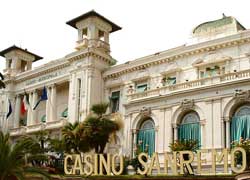Holidays in Sanremo
.jpg) The name Sanremo derives from San Romolo , who was bishop of Genoa and died as a Hermit around the 7th - 8th century, and gave its name to the Civitas Sancti Romuli on the hill called La Pigna .
The name Sanremo derives from San Romolo , who was bishop of Genoa and died as a Hermit around the 7th - 8th century, and gave its name to the Civitas Sancti Romuli on the hill called La Pigna .
The Italianization of San RÖmu has become San Remo. It is among the most fashionable Ligurian cities, thanks to the many events that accompany it during the year and is the main Italian flower market ( Riviera dei Fiori ), as well as the very famous Italian Song Festival which has been held at the Ariston theater since 1951.
To see in Sanremo
La Pigna is the medieval district with small squares and fountains, dominated from above by the Sanctuary of the Madonna della Costa from 1630. The district has an older part, with medieval doors and oratories and a late medieval one, with P iazza Cisterna and the alleys . The long alleyway at the foot of the hill leads from Piazza Colombo to Piazza Eroi Sanremesi , with the Torre della Ciapela which was part of the 16th century walls and the food market.
 The Cathedral of San Siro , dating back to the 12th century and restored at the beginning of the 20th century, eliminating the remains of the Baroque in favor of the Romanesque original, preserves a Crucifix by Maragliano and a carved tabernacle from the 16th century. Next to it is the Baptistery and opposite, the Oratory of the Immaculate Conception of the sixteenth century.
The Cathedral of San Siro , dating back to the 12th century and restored at the beginning of the 20th century, eliminating the remains of the Baroque in favor of the Romanesque original, preserves a Crucifix by Maragliano and a carved tabernacle from the 16th century. Next to it is the Baptistery and opposite, the Oratory of the Immaculate Conception of the sixteenth century.
Seat of the Festival since 1977, the Ariston Theater is located in via Matteotti, the center of the city's social life, with shops and restaurants. Here is Palazzo Borea D'Olmo (XVI - XVII century), seat of the Civic Museum with archaeological finds, Garibaldi objects and paintings of the eighteenth - nineteenth century. The municipal casino from the beginning of the century and the Russian Orthodox Church commissioned by Tsarina Maria Alexandrovna in 1875, mark the beginning of Corso degli Inglesi which climbs the hills where the 1890 Devachan Castle is located. the winter between 1874 and 1875, to donate to Sanremo the palm trees that line the Promenade of the Empress that leads to the sea.
The Porto Vecchio , where the Forte di Santa Tecla , an eighteenth-century Genoese work , is located, leads to the tourist Porto Sole , on whose beach the Bagni Morgana Victory are an example of rationalist architecture. Corso Cavallotti , behind Porto Sole, leads to the botanical park of Villa Ormond and to Villa Nobel where the Swedish scientist died in 1896 and which now houses a museum.
Finally, on the sea, near the monumental cemetery , there are the remains of a Roman villa from the 1st - 2nd century.